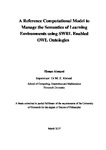A Reference Computational Model to Manage the Semantics of Learning Environments using SWRL Enabled OWL Ontologies
| dc.contributor.supervisor | Ahmed, Mohammed Zaki | |
| dc.contributor.author | Almami, Eiman | |
| dc.contributor.other | School of Engineering, Computing and Mathematics | en_US |
| dc.date.accessioned | 2017-03-29T13:19:59Z | |
| dc.date.issued | 2017 | |
| dc.identifier | 10425118 | en_US |
| dc.identifier.uri | http://hdl.handle.net/10026.1/8735 | |
| dc.description.abstract |
This thesis proposes a reference model and its computational core to support the creation of software applications within educational environments, which address Differences In Learning (DiffInL) and are applicable to both learners and instructors. This work differs from others in that the strength of this model resides on the re-usable character of the reasoning mechanism enabled by the computational environment. The starting point is the definition of agreed learning goals that the learner needs to achieve. In turn, the reference model generates personalised, best-practice teaching and learning materials, suitable for achieving the individual’s learning goals. This reference model consists of MODEL and MANAGEMENT components. The MODEL components store the domain needed to create learners and instructional models, which are required for the creation of Learning Spaces (LeS). The MANAGEMENT compo- nent also manages the semantics stored in various model components in order to carry out the configuration of an LeS. The architecture of software applications generated from the reference model is illustrated and contains: Netbeans IDE 8.0.2, JavaServer Faces framework and OWL-API library. We tested this to generate teaching practices for Learning Difficulties (LDif) student. In order to prove the feasibility of creating a software application from the reference model, an example of a particular scenario in a specific educational setting for LDif Students has been shown. This proposed model has successfully proved its ability to address the needs of LDif Students through a corresponding novel and re-usable reasoning mechanism implemented in Web Ontology Language (OWL) and Semantic Web Rule Language (SWRL) computational environments. The reference model has shown its ability to integrate with different disciplines such as psychology, sociology and human-computer interactions. The main contribution to research is the creation of a novel reference computational model which addresses the needs of people with DiffInL. The strength of this model resides on the re-usable character of the reasoning mechanism enabled by the computational environment. The whole framework allows a unified implementation which takes into account classes, constraints, matching, and inference mechanisms for the complete configuration of an LeS. The suggested approach also differs from previous work in that it is personalised, and the applied reasoning rules are dynamic. Therefore this model can be constantly “tuned” according to the questions we may ask in such environments. Overall, the proposed reference model in this research offers a promising and feasible solution that can support current educational systems and benefit both learners and instructors. It also demonstrates the applicability of the latest technologies and would allow for future technologies to be incorporated, in order to enhance the model. | en_US |
| dc.language.iso | en | |
| dc.publisher | University of Plymouth | |
| dc.subject | Reference Model | en_US |
| dc.subject | Software Applications | en_US |
| dc.subject | Differences in Learning | en_US |
| dc.subject | Learning Difficulties | en_US |
| dc.subject | Learning Environments | en_US |
| dc.subject | Learning Spaces | en_US |
| dc.subject | OWL/SWRL | en_US |
| dc.subject | Ontology | en_US |
| dc.subject.classification | PhD | en_US |
| dc.title | A Reference Computational Model to Manage the Semantics of Learning Environments using SWRL Enabled OWL Ontologies | en_US |
| dc.type | Thesis | |
| plymouth.version | publishable | en_US |
| dc.identifier.doi | http://dx.doi.org/10.24382/1241 | |
| dc.rights.embargodate | 2018-03-29T13:19:59Z | |
| dc.rights.embargoperiod | 12 months | en_US |
| dc.type.qualification | Doctorate | en_US |
| rioxxterms.version | NA |
Files in this item
This item appears in the following Collection(s)
-
01 Research Theses Main Collection
Research Theses Main


